Response Services
-
- Maritime Response Services & Non-Tank Vessel Response Plans Maritime Reporter, Sep 2018 #48
Avoiding Potential Pitfalls and Headaches
The summer of Sub M may be over, but the heat remains for the tugboat and towing vessel industry operating under the July 20th regulations. Owner & Operators are faced with daily challenges to continually sustain and build their businesses. As with any new regulation, there is a period of learn-ing and, even more so, interpretation by industry and by those enforcing regulations. One of the more significant matters related to this situation revolves around vessels in response services and those required to hold Non-Tank Vessel Response Plans (NT-VRP). Navigating through these regula-tions can be complicated, but this article will help identify how to avoid those potential pitfalls and headaches.
It is important to start with some basic background on why tugboats and towing vessels have been required to maintain certified Non-Tank Vessel Response Plan (NT-VRP) prior to Subchapter M. The heart of the issue is found simply in the CFRs (Code of Federal Regulation). Subchapter M is part of 46 CFR, which refers to Shipping. 46 CFR is focused primarily on safety of a vessel through inspec-tions, training and equipment standards. Whereas, response and spill mitigation requirements are found in 33 CFR which refers to Navigation and Navigable Waters, including pollution prevention. Each section of CFR identifies those vessels, individuals or sectors of industry that must comply with the regulation.
There are four areas that Owners & Operators should currently evaluate within their own operation that may involve a potential operator oversight or conflict between their Subchapter M Certificate of Inspection (COI) and what may have previously worked in their response services or NT-VRP approval (33 CFR 155, Subpart J) process.
Those potential conflicts may include:
1. Geographic Limitations
2. International vs. Domestic Tonnage Requirements
3. Total Number of Manning (for Certain Response Services)
4. Conditions of Operation & Restrictions
Let’s examine those four areas a bit closer.
1.Geographic Limitations:
Owners and operators must understand that vessels must comply with permitted routes that their COI authorizes them to operate on. Geographic limitations to operating areas and restrictions on operating conditions may now be different than the vessel’s capabilities at the time the NT-VRP was approved. Currently, the United States Coast Guard will not be providing any additional grace periods for operators to comply with this Subchapter M re-quirement.
The COI permitted routes does not restrict the vessel to a Geographic Specific Area (GSA), but rather is classified by the restricted distance from land that a vessel may operate. Terms such as Inland, Great Lakes, Lakes, Bays, Sounds & Rivers, Limited Coastwise beyond 3 nauti-cal miles, Coastwise not to exceed 20 nautical miles and Oceans are placed on the vessel’s COI to distinguish this permitted operating distance.
It is important to know that the COI identifies permitted routes based off the operating dis-tance from land, not through specific Captain of the Port (COTP) zones or GSA. Due to this measurement process, it still allows operators to navigate lengthy voyages. If a vessel’s COI states Limited Coastwise beyond 3 nautical miles, the vessel can transit along the east coast to the Gulf of Mexico. However, the vessel must operate within 3nm from land for the entire voyage.
2.International vs. Domestic tonnage requirements (NVIC-01-05)
Prior to Subchapter M, some may not have known that there were two different ways to measure a vessel’s tonnage. The traditional domestic gross registered tonnage (GRT) was typically the only reference to measuring a vessel’s tonnage for many years. However, there is a second means to measurement, referred to as gross tonnage (GT) measurements using the international tonnage certification (ITC) (46 USC 14302 (the Convention measurement system)). ITC has been in place since 2004, but did not require vessels without this meas-urement to get it done. The critical and complicated piece to know is that both are tonnage measurements, however, both have drastically different numerical outcomes. Vessels may have 99 GRT measurement, but a 400 GT (ITC) measurement. USCG NVIC 01-05 was pub-lished nearly 13 years ago to help support and provide guidance on the topic along with the process of identifying the NT-VRP requirements.
Owners and Operators must be aware that this international measurement changes many regulatory compliance areas, specifically in 33 CFR Part 155 for response plans, including Salvage and Fire Fighting operations. Although, ITC has not been hidden to the world, it is important to realize that Subchapter M has opened up this requirement to inspectors, audi-tors and others.
3.Total Number of Manning (for Certain Response Services)
The tugboat and towing vessels industry is beginning to see the first round of COIs be issued across the nation. One of areas noted on the COI that has drawn the most attention is to the manning requirements placed on the vessel.
Vessels operating in salvage and marine firefighting and other emergency services may no-tice that additional manning requirements have been required on their COI. This require-ment is intended to ensure that vessels meet regulatory planning criteria including manning resources to reinforce existing efforts among plan holders and their respective service pro-viders in geographic specific areas where their vessels operate. Additional manning is not uncommon to see on vessels that have specialized non-routine services.
4.Conditions of Operation & Restrictions
The last area for Owners/Operators to evaluate is related to restrictions or special condi-tions to operations for their vessel. The conditions of operation may affect your operating prowess, but also have financial consequences that may need to be planned for to limit busi-ness exposure. The COI may identify special requirements for weather conditions, such as wind strength or sea state severity that may limit or restrict your vessel operations. Other areas may include carriage of equipment and personnel, or requirements specific to associ-ated services such as salvage and marine firefighting or emergency towing.
Each of these four areas identified are meant to be used a guidance for self-evaluation of your cur-rent regulatory standing during the sometimes confusing interpretation period. Additionally, there are other options to provide further support on the subject matter to make sure your operation is running at optimal performance. Events such as Green Apple Spill Response Exercise in the New York City area on September 28, Clean Gulf in New Orleans on November 15, as well as others are great opportunities to evaluate your current response plans and speak with other professionals as-sociated with response efforts. Lastly, remember that you always have a direct route to discuss Sub-chapter M compliance by contacting to your local United States Coast Guard Sector and the OCMI.The Author
Richard Paine is a licensed mariner, certified TSMS & AWO-RCP Lead Auditor and DPA with over 20 years of maritime and auditing experience ranging from deep sea, tugs & towing, and passenger vessels. He is an alumnus of SUNY Maritime College in both undergraduate and graduate studies. A member of PVA’s Safety & Security Committee, he is currently is the Regional Director, HSSQE for Hornblower’s NYC Ferry & Statue Cruises operations. Richard can be reached at [email protected]
-
- Non-tank Vessel Response Rules – Their Impact Examined Marine News, Dec 2013 #36
waters of the United States and carry any kind of oil as fuel for main propulsion. It is noteworthy that the NTVRP requirements for planning of response services are scaled to oil carrying capacity. Hence, small non-tank vessels with less oil carrying capacities will have fewer functional planning requirements
-
- Future Of Marine Emergency Services Now Under Scrutiny Maritime Reporter, Nov 1991 #68
Three separate investigations into the future of emergency response services at sea are now under way. The International Salvage Union (ISU), representing 38 marine salvors in 26 countries, is participating in each study. The primary aim, in all cases, is to ensure that adequate emergency response se
-
- Fort Ripley: Multi-Missioned & Fully Capable Marine News, Nov 2014 #107
. The Fort Ripley, powered by triple Volvo Penta IPS drives, is a U.S. Coast Guard-certificated 64-ft. aluminum boat, owned by Southeast Ocean Response Services Inc. Built by Gladding-Hearn Shipbuilding, Duclos Corporation, and designed by C. Raymond Hunt Associates, the boat’s primary mission will be
-
- Marine Salavage: Responder Immunity Benefits a Responsible Party Maritime Logistics Professional, Q2 2014 #58
costs if adequate responder immunity is not available and will ultimately pay for the responder’s increased insurance rates through higher costs for response services which will be passed along to the RP. This is exactly what happened as a result of the Deepwater Horizon incident due to the claims against responders
-
- OSRO: The Child of Necessity Maritime Reporter, Jul 2014 #14
and their shipping subsidiaries established the Marine Spill Response Corporation (MSRC). When the MSRC initially declined to provide spill response services to smaller tanker companies, the National Response Corporation (NRC) was created to fill the void. Subsequently, a number of companies and joint
-
- Volvo Penta Triple IPS and DP for New Fast Response Boat Maritime Reporter, Nov 2014 #138
Penta IPS drives. Designed by C. Raymond Hunt Associates, built by Gladding-Hearn Shipbuilding, Duclos Corporation, and owned by Southeast Ocean Response Services Inc., the USCG-certificated 64-ft. aluminum boat, was commissioned in early October. Fort Ripley’s primary mission is to allow ships to meet
-
- Crowley Delivers Last Of Prevention Tug Series Maritime Reporter, Sep 2000 #23
oil spills by assisting tankers in safe navigation through Prince William Sound, and to protect the environment by providing rapid and effective response services to the Valdez Marine Terminal and Alaska crude oil shippers. During sea trials, Aware generated a certified bollard pull of 305,000-lbs. and a
-
- Interview: Oil Spill Repsonse Insights from MSRC's Benze: Steven T. Benz, President and CEO, Marine Spill Response Corporation (MSRC) Marine News, Dec 2014 #12
national basis, especially for large-scale discharge events. It was anticipated that MSRC would provide both compliance planning resources as well as response services to all operators that required Worst Case Discharge Services through an agreed upon cost sharing formula according to volumes processed or moved
-
- Seacor Continues Rational Fleet Expansion Maritime Reporter, Apr 2001 #44
world's premier operators of a fleet of vessels that provide marine services to the oil and gas exploration and pro- duction industry, and oil spill response services in the U.S. Gulf of Mexico, North Sea, offshore West Africa, the Far East and Latin America. For the fiscal year ended December 31, 2000
-
- 2018 Green Apple Spill Exercise Marine News, Dec 2018 #22
an oil spill catastrophe in New York Harbor.As in previous years, participants from multiple sectors were in attendance representing a vast array of response services. Importantly, this year’s Exercise included over 25 representatives from United States Coast Guard Sector New York, the U.S. Environmental Protection
-
- Op/Ed: The Spill Response Industry's Greatest Challenges Marine News, Jun 2017 #18
specific and inclusive responder immunity legislation to ensure that our response community is adequately protected when the bell rings. Professional response services acting responsibly under the oversight of the federal government should have the same level of immunity that is granted to our public response
-
 )
March 2024 - Marine Technology Reporter page: 48
)
March 2024 - Marine Technology Reporter page: 48Index page MTR MarApr2024:MTR Layouts 4/4/2024 3:19 PM Page 1 Advertiser Index PageCompany Website Phone# 17 . . . . .Airmar Technology Corporation . . . . . . . . . .www.airmar.com . . . . . . . . . . . . . . . . . . . . . . . . . . . . . . . . .(603) 673-9570 9 . . . . . .Birns, Inc. . . . . . . . . . .
-
 )
March 2024 - Marine Technology Reporter page: 45
)
March 2024 - Marine Technology Reporter page: 45ronments. The new agreement will address speci? c techni- cal gaps in the UUV defense and offshore energy markets especially for long duration, multi-payload mission opera- tions where communications are often denied or restricted. As part of the new alliance, Metron’s Resilient Mission Autonomy portfolio
-
 )
March 2024 - Marine Technology Reporter page: 13
)
March 2024 - Marine Technology Reporter page: 13, or dozens of other missions – has driven advance- ments in glider technology to meet the modern demand for long-term data gathering of all kinds. In response, Teledyne Webb Research has announced the launch of their new- est product in the ? eld of buoyancy engine driven underwater vehicles: the Slocum
-
 )
March 2024 - Marine Technology Reporter page: 9
)
March 2024 - Marine Technology Reporter page: 9from marinas along the western coast. The exact number of lizing laser detection systems can detect mines just below the mines, as well as their locations, remains largely a mystery, surface, even those hiding in murky water. The Airborne Laser although reports suggest that over three hundred have been
-
 )
March 2024 - Marine Technology Reporter page: 6
)
March 2024 - Marine Technology Reporter page: 6MTR Editorial Advisors Gallaudet Hardy The Honorable Tim Gallaudet, Kevin Hardy is President PhD, Rear Admiral, U.S. of Global Ocean Design, Navy (ret) is the CEO of creating components and Ocean STL Consulting and subsystems for unmanned host of The American Blue vehicles, following a career
-
 )
March 2024 - Marine Technology Reporter page: 4
)
March 2024 - Marine Technology Reporter page: 4Editorial NIWA-Nippon Foundation TESMaP/ Rebekah Parsons-King www.marinetechnologynews.com ast month marked the resounding NEW YORK 118 E. 25th St., New York, NY 10010 return of Oceanology Interna- Tel: (212) 477-6700; Fax: (212) 254-6271 tional in London, perennially one Lof the world’s most important
-
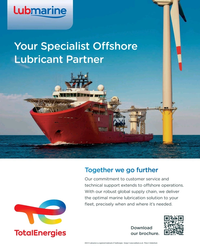 )
April 2024 - Maritime Reporter and Engineering News page: 3rd Cover
)
April 2024 - Maritime Reporter and Engineering News page: 3rd CoverYour Specialist Ofshore Lubricant Partner T Togeth her w we go o furt ther r Our commitment to customer service and technical support extends to ofshore operations. With our robust global supply chain, we deliver the optimal marine lubrication solution to your ?eet, precisely when and where it’s needed.
-
 )
April 2024 - Maritime Reporter and Engineering News page: 48
)
April 2024 - Maritime Reporter and Engineering News page: 48Index page MR Apr2024:MN INDEX PAGE 4/5/2024 1:33 PM Page 1 ANCHORS & CHAINS MILITARY SONAR SYSTEMS tel:+44 (0) 1752 723330, [email protected] , www.siliconsensing.com Anchor Marine & Supply, INC., 6545 Lindbergh Houston, Massa Products Corporation, 280 Lincoln Street, SONAR TRANSDUCERS
-
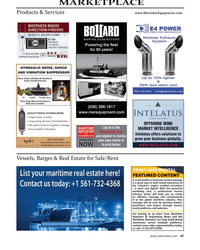 )
April 2024 - Maritime Reporter and Engineering News page: 47
)
April 2024 - Maritime Reporter and Engineering News page: 47MARKETPLACE Products & Services www.MaritimeEquipment.com Powering the fleet for 60 years! HYDRAULIC NOISE, SHOCK AND VIBRATION SUPPRESSOR Noise, Shock, VibraO on & PulsaO on in Quiet, Smooth Flow Out Oil Bladder Nitrogen (blue) Manufactured by MER
-
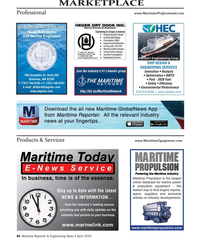 )
April 2024 - Maritime Reporter and Engineering News page: 46
)
April 2024 - Maritime Reporter and Engineering News page: 46MARKETPLACE Professional www.MaritimeProfessional.com GILBERT ASSOCIATES, INC.GILBERT ASSOCIATES, INC. Naval Architects and Marine Engineers SHIP DESIGN & ENGINEERING SERVICES Join the industry’s #1 Linkedin group )NNOVATION
-
 )
April 2024 - Maritime Reporter and Engineering News page: 43
)
April 2024 - Maritime Reporter and Engineering News page: 43he also chairs the Waterborne Technol- and digitalized maritime technology. ship capacity substantially. ogy Platform, which provides policy “One response might be to build more Technology as Tool guidance to the European Commission ships, but even a shameless opportunist on maritime R&D. With industry
-
 )
April 2024 - Maritime Reporter and Engineering News page: 42
)
April 2024 - Maritime Reporter and Engineering News page: 42. Two systems op- ingly reliant on digital technology, the of them are crucial,” said Lehtovaara. erating in storm conditions can base their progressive response from shipping is “Shipping is the most ef? cient way of analyses on different ef? ciency param- to engage more closely with solution 42 Maritime
-
 )
April 2024 - Maritime Reporter and Engineering News page: 38
)
April 2024 - Maritime Reporter and Engineering News page: 38long and 85,474 and solid waste, transporting personnel and provisions, and oil gt, was moored using the 3-ton pulling capacity of the moor- spill response services. Images courtesy Consulmar Crowley's New LNG Containerships Carbon Capture @ Sea Crowley shared ? rst renderings and the names of its four
-
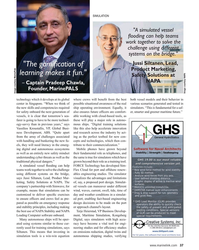 )
April 2024 - Maritime Reporter and Engineering News page: 37
)
April 2024 - Maritime Reporter and Engineering News page: 37and weather conditions in a simulat- to ensure of? cers and crews feel as pre- ed port, enabling fact-based engineering pared as possible on emergency response design decisions to be made on the port and stability principles, including making or approach channel's layout. the best use of NAPA Stability
-
 )
April 2024 - Maritime Reporter and Engineering News page: 28
)
April 2024 - Maritime Reporter and Engineering News page: 28FEATURE INTERVIEW track missiles and warheads for the Mis- sile Defense Agency, and it travels with its support ship, the MV Hercules. For our Service Support ships, we have the two hospital ships, USNS Mer- cy and Comfort; two rescue and salvage ships; two submarine tenders; and the Sixth Fleet ?
-
 )
April 2024 - Maritime Reporter and Engineering News page: 27
)
April 2024 - Maritime Reporter and Engineering News page: 27RADM PHILIP SOBECK, MILITARY SEALIFT COMMAND With COVID, we had to make some hard choices for our Do your CIVMARs have upward mobility? mariners because we couldn’t rotate. Many of our mariners The Navy has Sailors who become “Mustangs,” and work found other employment, and were able to use their skills
-
 )
April 2024 - Maritime Reporter and Engineering News page: 25
)
April 2024 - Maritime Reporter and Engineering News page: 25RADM PHILIP SOBECK, MILITARY SEALIFT COMMAND Photo by Brian Suriani USN Military Sealift Command From a global supply chain perspective, What makes MSC so vital to the we’ve learned a lot about dealing with Navy’s ? eet and our military disruptions. COVID delivered a big forces around the world? wake-up
-
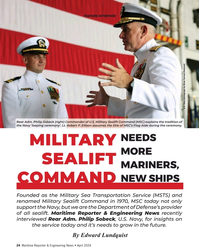 )
April 2024 - Maritime Reporter and Engineering News page: 24
)
April 2024 - Maritime Reporter and Engineering News page: 24FEATURE INTERVIEW U.S. Navy photograph by Brian Suriani/Released Rear Adm. Philip Sobeck (right) Commander of U.S. Military Sealift Command (MSC) explains the tradition of the Navy ‘looping ceremony’. Lt. Robert P. Ellison assumes the title of MSC’s Flag Aide during the ceremony. NEEDS MILITARY MORE
-
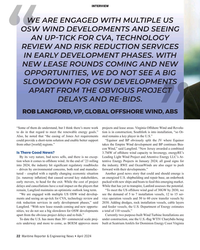 )
April 2024 - Maritime Reporter and Engineering News page: 22
)
April 2024 - Maritime Reporter and Engineering News page: 22INTERVIEW WE ARE ENGAGED WITH MULTIPLE US OSW WIND DEVELOPMENTS AND SEEING AN UP-TICK FOR CVA, TECHNOLOGY REVIEW AND RISK REDUCTION SERVICES IN EARLY DEVELOPMENT PHASES. WITH NEW LEASE ROUNDS COMING AND NEW OPPORTUNITIES, WE DO NOT SEE A BIG SLOWDOWN FOR OSW DEVELOPMENTS APART FROM THE OBVIOUS
-
 )
April 2024 - Maritime Reporter and Engineering News page: 21
)
April 2024 - Maritime Reporter and Engineering News page: 21ROB LANGFORD, VP, GLOBAL OFFSHORE WIND ob Langford has worked in the offshore industry ABS. “We are growing and evolving our services across all for more than three decades, ‘cutting his teeth’ offshore infrastructure along with our continued support to the in a UK design ? rm working in the North Sea
-
 )
April 2024 - Maritime Reporter and Engineering News page: 16
)
April 2024 - Maritime Reporter and Engineering News page: 16MARKETS SOVs – Analyzing Current, Future Demand Drivers By Philip Lewis, Director of Research, Intelatus © Björn Wylezich/AdobeStock t a high-level, there are three solutions to transferring Lower day rate CTVs are often used for daily transfer of technicians from shore bases to offshore wind farms
-
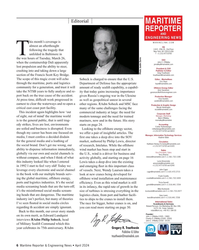 )
April 2024 - Maritime Reporter and Engineering News page: 6
)
April 2024 - Maritime Reporter and Engineering News page: 6Editorial MARITIME REPORTER AND ENGINEERING NEWS his month’s coverage is M A R I N E L I N K . C O M almost an afterthought HQ 118 E. 25th St., 2nd Floor following the tragedy that New York, NY 10010 USA T +1.212.477.6700 Tunfolded in Baltimore in the wee hours of Tuesday, March 26, CEO John C.
-
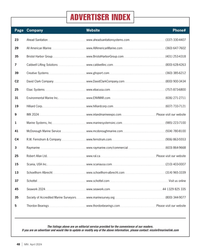 )
April 2024 - Marine News page: 48
)
April 2024 - Marine News page: 48ADVERTISER INDEX Page Company Website Phone# 23 Ahead Sanitation www.aheadsanitationsystems.com (337) 330-4407 29 All American Marine www.AllAmericanMarine.com (360) 647-7602 35 Bristol Harbor Group www.BristolHarborGroup.com (401) 253-4318 7 Caldwell Lifting Solutions www.caldwellinc.com (800)
-
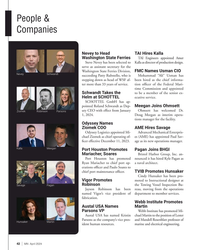 )
April 2024 - Marine News page: 42
)
April 2024 - Marine News page: 42People & Companies Nevey to Head TAI Hires Kalla Washington State Ferries TAI Engineers appointed Amer Steve Nevey has been selected to Kalla as director of production design. serve as assistant secretary for the FMC Names Usman CIO Washington State Ferries Division, Nevey Schwandt succeeding Patty
